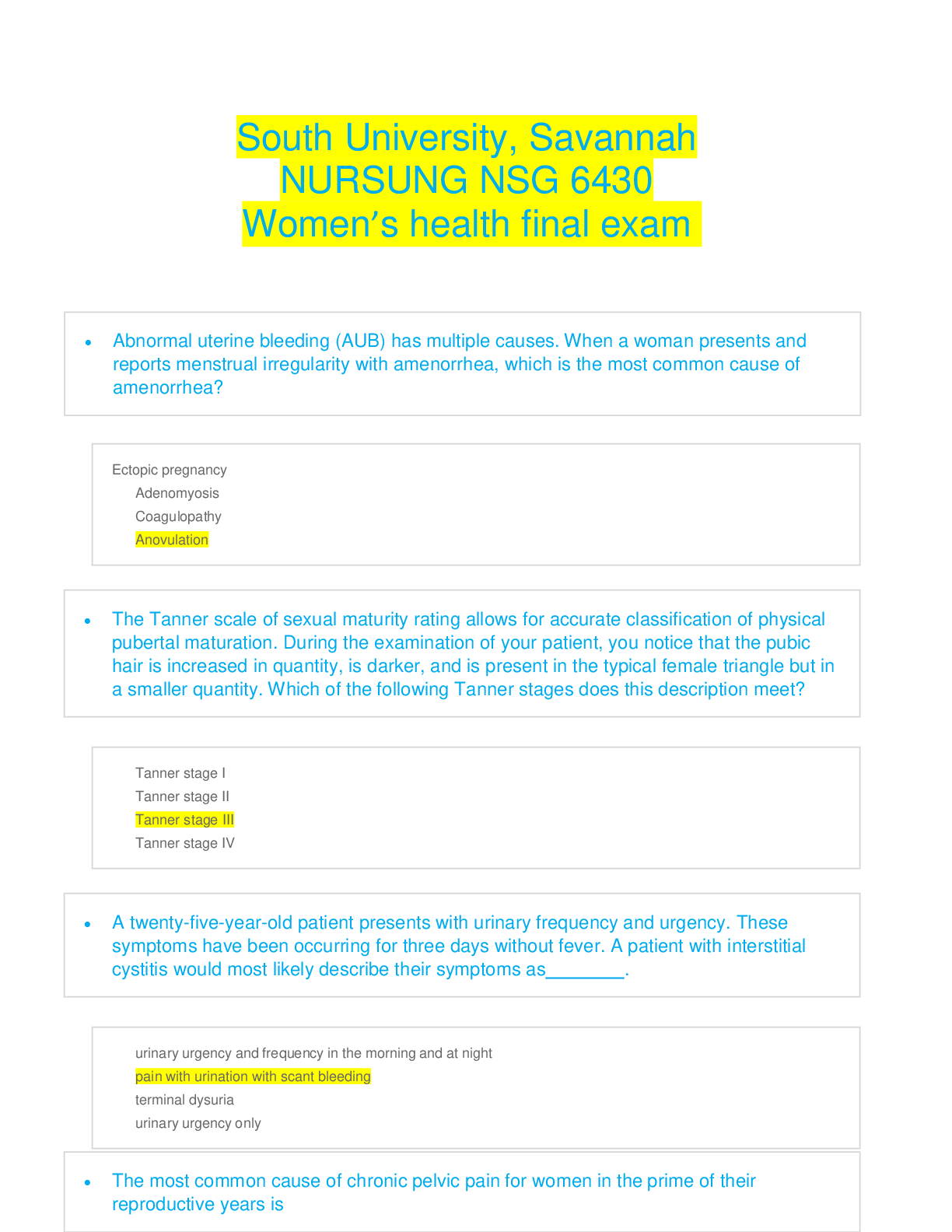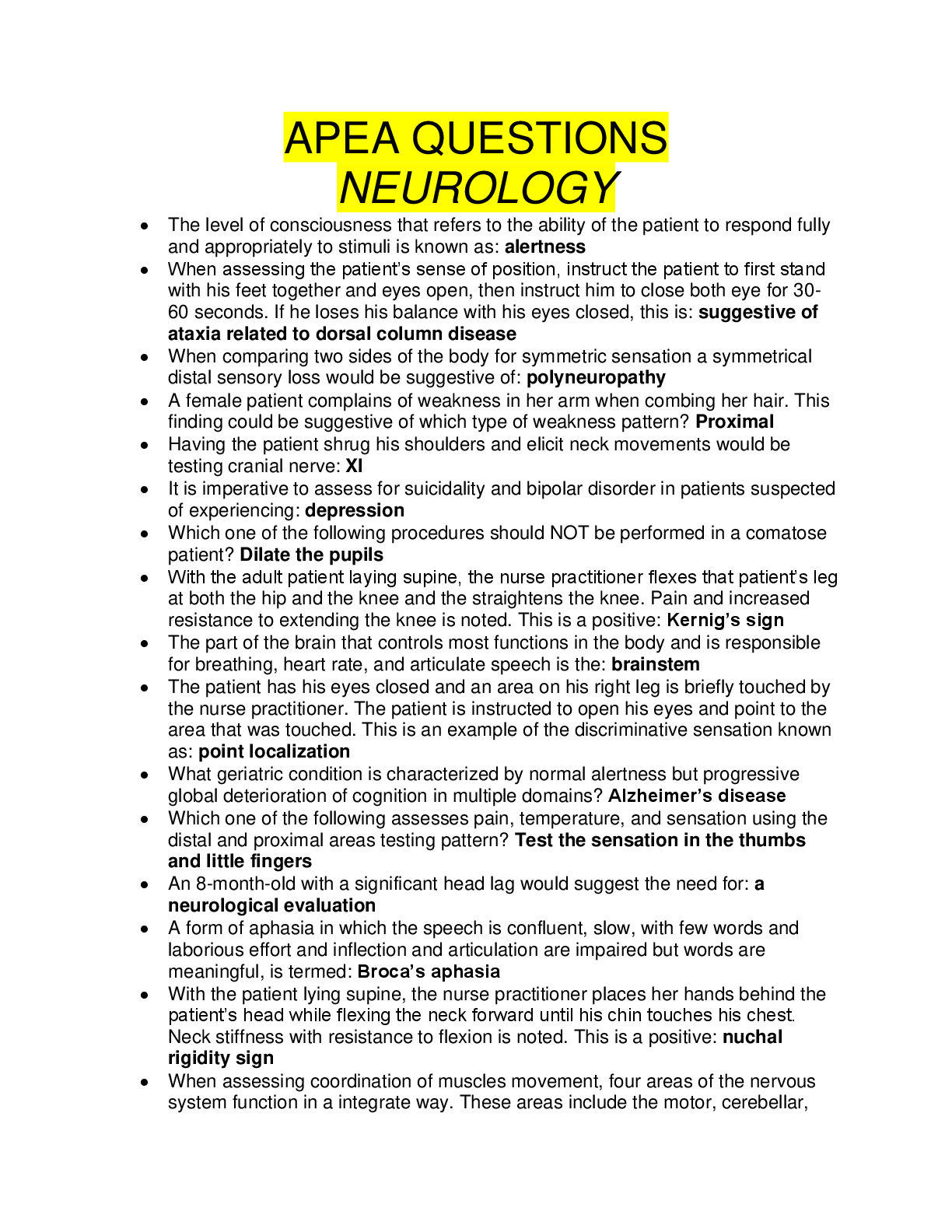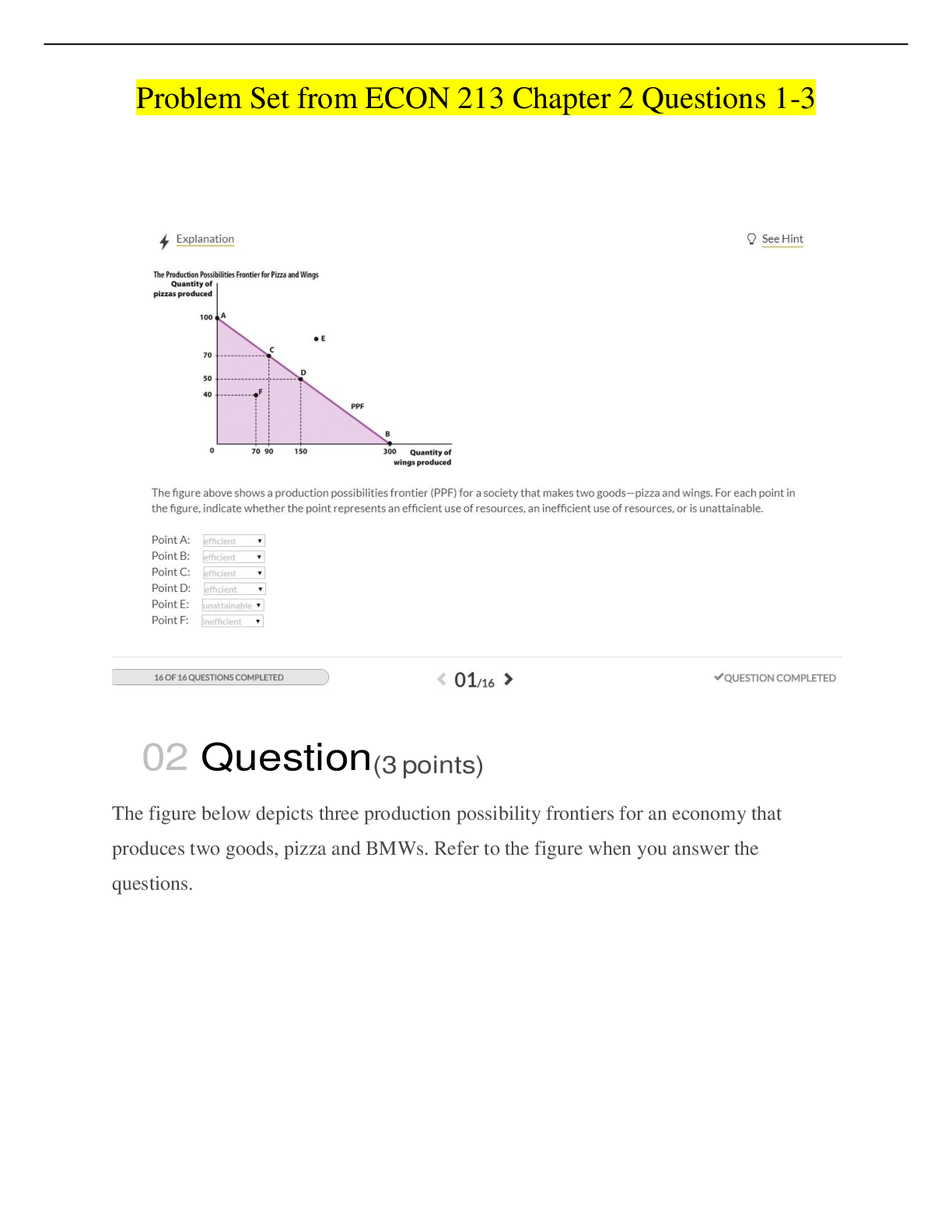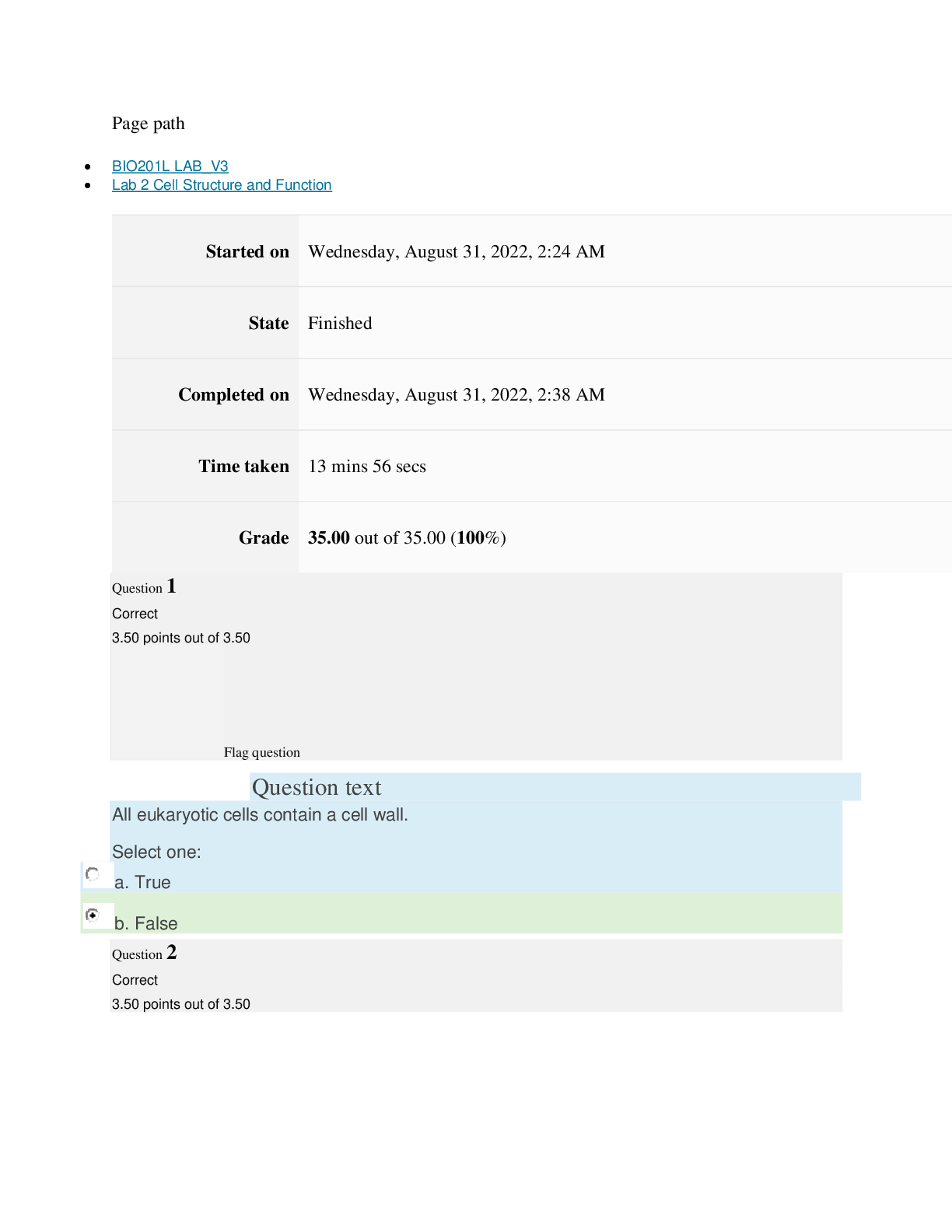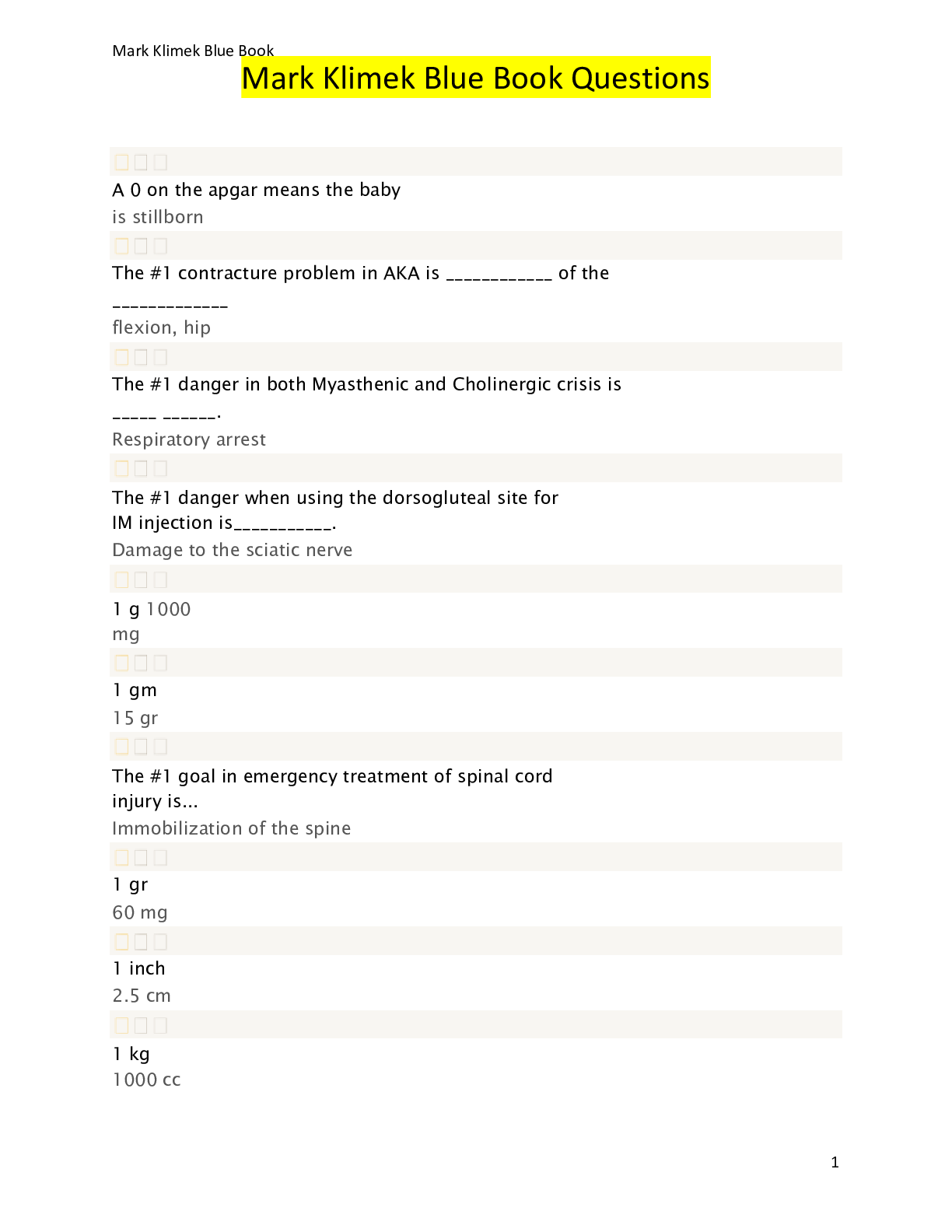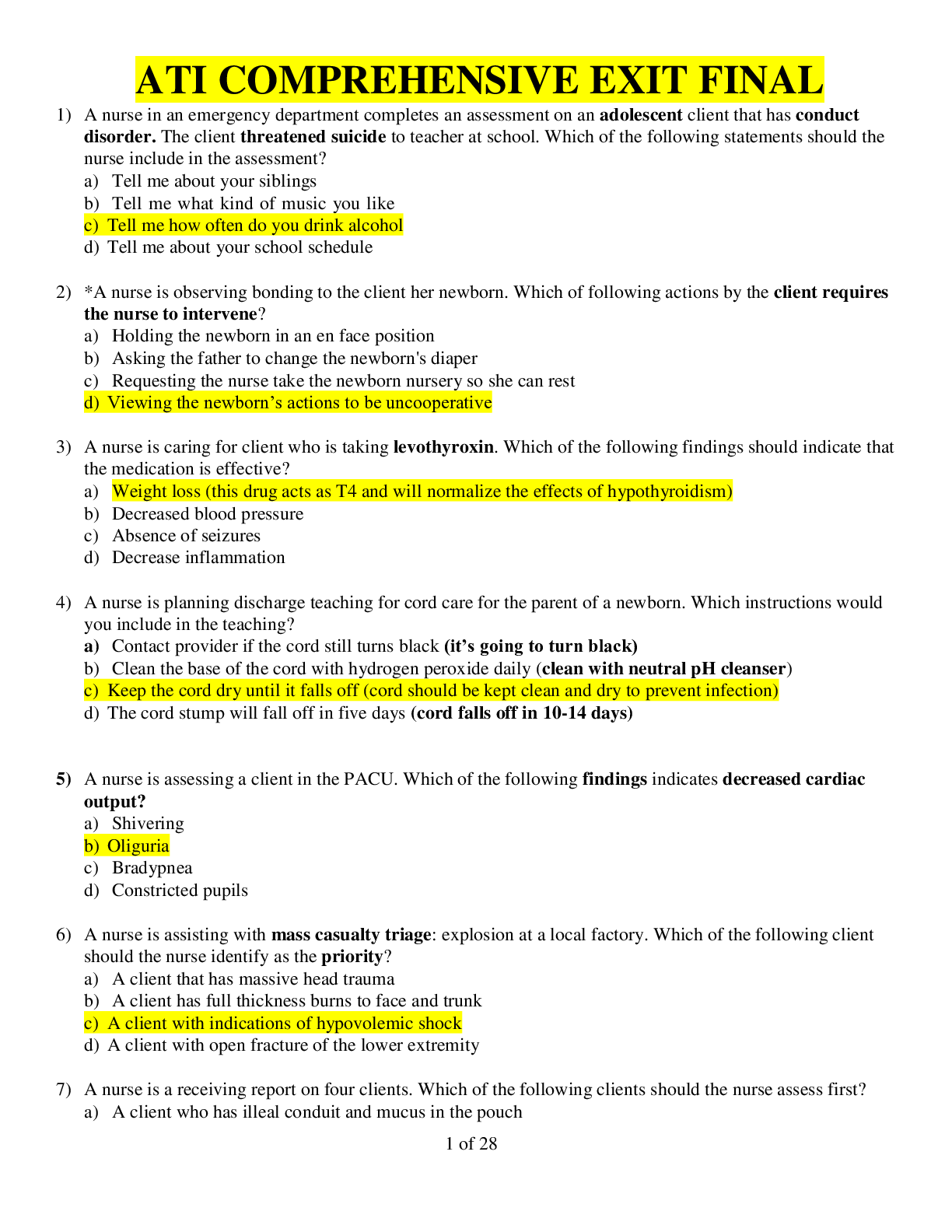*NURSING > QUESTIONS & ANSWERS > Chapter 9--Genetics and the Multiple Determinants of Health (All)
Chapter 9--Genetics and the Multiple Determinants of Health
Document Content and Description Below
Chapter 9--Genetics and the Multiple Determinants of Health MULTIPLE CHOICE 1. A client is found to be heterozygous for a normal gene and an abnormal gene. The nurse realizes this client would ... be considered a(n): 1. affected individual. 2. carrier. 3. genetically defective. 4. mutated individual. PTS: 1 DIF: Analyze REF: Fundamentals of Genetics 2. A client is diagnosed with a chromosomal abnormality that occurred during cell division and resulted in the formation of two cells, each with the same chromosome complement as the parent cell. The nurse realizes that the abnormality occurred during: 1. conception. 2. birth. 3. meiosis. 4. mitosis. PTS: 1 DIF: Analyze REF: Chromosomal Abnormalities 3. From genetic testing, a client is found to have the correct number of chromosomes within cells. The nurse would document this finding as being: 1. aneuploidy. 2. diploid. 3. euploidy. 4. haploid. PTS: 1 DIF: Apply REF: Abnormalities of Chromosome Number 4. From genetic testing, a fetus is determined to have genetic trisomy. The nurse realizes that the most common trisomy condition is: 1. Down syndrome. 2. Edward syndrome. 3. Marfan syndrome. 4. Patau syndrome. PTS: 1 DIF: Analyze REF: Trisomies 5. A pregnant client is scheduled for a procedure to harvest stem cells from the fetus’s umbilical cord. Which of the following must occur before this procedure can be conducted? 1. Fetoscopy fails. 2. Umbilical cord is visualized upon ultrasound. 3. Chorionic villus sampling test has been completed. 4. Placental biopsy is completed. PTS: 1 DIF: Analyze REF: Prenatal Procedures: Percutaneous Umbilical Blood Sampling 6. The nurse is concerned that a pregnant client may deliver an infant with a teratogenic condition when which of the following is assessed? 1. Client ingests two alcoholic drinks every night during pregnancy. 2. Client exercises 3 days each week for 30 minutes. 3. Client works 40 hours a week. 4. Client eats six servings of fruits and vegetables each day. PTS: 1 DIF: Analyze REF: Congenital Anomalies and Chromosomal Syndromes 7. An adolescent female client being treated for cystic fibrosis is asking the nurse about birth control. Which of the following should the nurse include in these instructions? 1. The chances that the client will become pregnant are small. 2. Women with cystic fibrosis can transmit this disorder to their children. 3. Pregnancy will cause the disease to go into remission. 4. The client has a good chance of having children without the disorder. PTS: 1 DIF: Apply REF: Cystic Fibrosis 8. After genetic testing, a client is found to have the apolipoprotein E genotype. The nurse realizes that this genotype predisposes the client to developing: 1. diabetes mellitus. 2. arthritis. 3. cystic fibrosis. 4. cardiovascular disease. PTS: 1 DIF: Analyze REF: Cardiovascular Disease 9. A client with a family history of cancer asks the nurse what he can do to prevent developing the disease. Which of the following should the nurse respond to this client? 1. “Everyone develops cancer sometime in his life.” 2. “There are lifestyle changes that you can make to avert the development of cancer.” 3. “If you have cancer in your family, you will also develop the disease.” 4. “Cancer cannot be prevented.” PTS: 1 DIF: Apply REF: Cancer 10. The nurse caring for a client diagnosed with sickle-cell anemia realizes that which of the following interventions has been shown to increase clients’ life expectancy? 1. Low-fat diet 2. Moderate exercise 3. Prophylactic antibiotic therapy 4. Vitamin D therapy PTS: 1 DIF: Analyze REF: Hemoglobinopathies 11. A client is diagnosed with a genetic disorder that could affect other members of her family. The conflict that could occur if this information is shared with the client’s family would be within the ethical principle of: 1. beneficence. 2. autonomy. 3. nonmaleficence. 4. justice. PTS: 1 DIF: Analyze REF: Autonomy 12. A client is receiving a vaccination against a known disease. The nurse realizes that the vaccine was created through the use of: 1. gene therapy. 2. pharmacogenomics. 3. genetic engineering. 4. oncogenomics. PTS: 1 DIF: Analyze REF: Genetic Engineering 13. The nurse is assessing a client’s hereditary and nonhereditary cancer risk factors in order to create a pictorial description of the incidence of cancer. The nurse is constructing a: 1. flow chart. 2. checklist. 3. database. 4. pedigree. PTS: 1 DIF: Apply REF: Expanded Roles for Nurses MULTIPLE RESPONSE 1. The nurse is caring for a client who is experiencing a disease process caused by a malformation from a normal pattern of development. When reviewing the principles of teratology to plan care for this client, the nurse reviews which basic principles? (Select all that apply.) 1. Drug development 2. Environmental influences 3. Gestational age when the exposure occurred 4. The agent 5. The route of exposure 6. Rate of placental transfer PTS: 1 DIF: Analyze REF: Principles of Teratology 2. A pregnant client is scheduled for diagnostic tests which cannot occur until the fetus is older than 18 weeks. Which of the following tests is this client most likely scheduled to have performed? (Select all that apply.) 1. Amniocentesis 2. Chorionic villus sampling 3. Fetoscopy with fetal skin biopsy 4. Periumbilical blood 5. Placental biopsy 6. Early amniocentesis PTS: 1 DIF: Analyze REF: Table 9-2 Prenatal Diagnosis Procedures 3. A client is diagnosed with an autosomal recessive inherited disease. Which of the following are examples of this type of inherited disease? (Select all that apply.) 1. Cystic fibrosis 2. D-resistant rickets 3. Sickle-cell disease 4. Tay-Sachs disease 5. Phenylketonuria 6. Galactosemia PTS: 1 DIF: Understand REF: Autosomal Recessive Inheritance 4. A client at 20 weeks gestation is scheduled for an ultrasound to diagnose fetal abnormalities. The nurse realizes that this diagnostic test is used to identify which of the following fetal anomalies? (Select all that apply.) 1. Diabetes mellitus 2. Spina bifida 3. Congestive heart failure 4. Hydrocephaly 5. Gastritis 6. Microcephaly PTS: 1 DIF: Analyze REF: Diagnostic Imaging 5. The ethics committee is meeting to discuss treatment options for a client diagnosed with a genetic disorder. When addressing the ethics of this client’s treatment, the committee will focus on which of the following ethical principles? (Select all that apply.) 1. Autonomy 2. Timeliness 3. Beneficence 4. Cost-effectiveness 5. Nonmaleficence 6. Justice ANS: 1, 3, 5, 6 PTS: 1 DIF: Apply REF: Table 9-3 Four Principles Support the Ethical Decision-Making Process [Show More]
Last updated: 2 years ago
Preview 1 out of 6 pages

Buy this document to get the full access instantly
Instant Download Access after purchase
Buy NowInstant download
We Accept:

Reviews( 0 )
$5.00
Can't find what you want? Try our AI powered Search
Document information
Connected school, study & course
About the document
Uploaded On
Jan 21, 2020
Number of pages
6
Written in
Additional information
This document has been written for:
Uploaded
Jan 21, 2020
Downloads
0
Views
120

